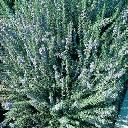
Rosemary
Product Info
A tender perennial shrub, rosemary is used to flavor many meat and vegetable dishes. The flavor is a little minty with a hint of pine and ginger. Thick, needle-like grayish-green leaves can be used crushed or chopped in your favorite recipes. Dried leaves and pale blue flowers can be used for making sachets. To store for later use, cut 4-5" pieces from the ends of the branches and store in the freezer. Frozen rosemary is stronger than fresh so adjust your recipes accordingly.
When harvesting rosemary, do not remove more than 20% of the growth at any one time. Take the tip cuttings you need to flavor your recipes, but don't cut the woody branches. Cutting these may irreversibly damage the plant. When you are ready to dry your rosemary, you should cut the sprigs in the early morning. Tie a few together and hang in a warm, dry place. When completely dry, store in plastic bags or jars. You can strip the leaves off the stems or keep them intact to add to a pan while cooking, then remove the stem before serving. The stems, if tough enough, also make excellent skewers for meats and vegetables on the grill, so if you strip the leaves before storing, save the stems also.
| Water: | Low |
| Mature: | 75 days |
| Planting and Growing Tips: | Plant when danger of frost has passed. Plant in full sun and well-drained soil. Once established, too much water or fertilizer will cause woody, brittle branches that will break easily. Definitely keep on the dry side and only water if the plant looks wilty during drought periods. Avoid planting by strawberries. |
| Light: | Full Sun |
| Spacing: | 36"-72" apart |
| Soil pH: | 5.0-6.0 |
| Fertilizer: | 5-10-5 at recommended rate when planted. Additional feedings are usually not needed. |
NOTICE: Please note not all plants are available all the time. The color and size can vary from photographs.
